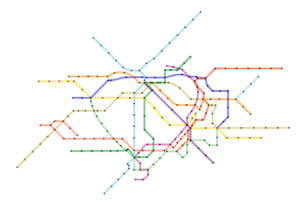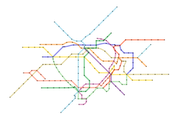Information
- Publication Type: Bachelor Thesis
- Workgroup(s)/Project(s): not specified
- Date: March 2021
- Date (Start): 2020
- Date (End): 2021
- Matrikelnummer: 11701221
- First Supervisor: Hsiang-Yun Wu
Abstract
Metro maps are essential when navigating through a public transportation network. They are schematic maps that have the aim to make orientation and navigation through a metro system easier. But creating them is quite complicated. Therefore numerous algorithms have been developed in the past trying to generate these maps automatically. The downside to using this approach is, that the designer only has limited possibilities to influence the resulting layout as well as contextual information of the city can not be taken into account. In order to overcome this limitation, this thesis presents a method where a potential user could influence the resulting layout by adding a set of guide paths. This method can be used to create artistically pleasing metro maps as well as make metro lines follow symbolic shapes in the layout. A mixed-layout – where some edges are rotated to be parallel to the closest guide path and other parts are octilinear – is proposed to integrate the guide paths better into the layout. To outline the potentials of this approach, examples of several metro networks were generated and are later also discussed.Additional Files and Images
Weblinks
No further information available.BibTeX
@bachelorsthesis{Batik-2021,
title = "Embedding User-Defined Shapes into Metro Map Layouts",
author = "Tobias Batik",
year = "2021",
abstract = "Metro maps are essential when navigating through a public
transportation network. They are schematic maps that have
the aim to make orientation and navigation through a metro
system easier. But creating them is quite complicated.
Therefore numerous algorithms have been developed in the
past trying to generate these maps automatically. The
downside to using this approach is, that the designer only
has limited possibilities to influence the resulting layout
as well as contextual information of the city can not be
taken into account. In order to overcome this limitation,
this thesis presents a method where a potential user could
influence the resulting layout by adding a set of guide
paths. This method can be used to create artistically
pleasing metro maps as well as make metro lines follow
symbolic shapes in the layout. A mixed-layout – where some
edges are rotated to be parallel to the closest guide path
and other parts are octilinear – is proposed to integrate
the guide paths better into the layout. To outline the
potentials of this approach, examples of several metro
networks were generated and are later also discussed.",
month = mar,
address = "Favoritenstrasse 9-11/E193-02, A-1040 Vienna, Austria",
school = "Research Unit of Computer Graphics, Institute of Visual
Computing and Human-Centered Technology, Faculty of
Informatics, TU Wien ",
URL = "https://www.cg.tuwien.ac.at/research/publications/2021/Batik-2021/",
}

 thesis
thesis

